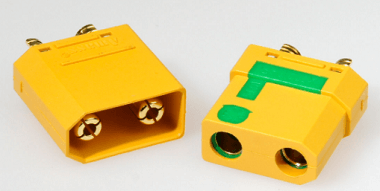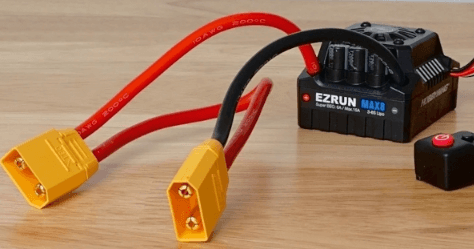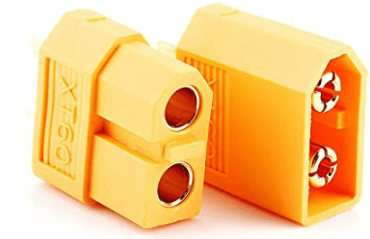Mark start research and blogging about five years ago beside his successful business about RC cars, ride-on toys, power wheels, etc. Although he is a...Read more
The xt60 and xt90 connectors have a lot to do when you’re doing electric connections in RC cars, solar panels, and similar other projects. Although they both do pretty much the same job, there are considerable differences between them.
So, xt90 vs xt60: which one is better?
Primarily, an xt60 has a delivery capacity of up to 60 amps, while an xt90 can go as high as 90 amps. Besides, the xt90 is a bigger plug when compared to an xt60.
Still, deciding which one of the two RC connectors is better than the other depends on some factors. So, this article will provide a detailed explanation of the properties of the two different connectors. Also, we’ll see the differences side by side to give you a clearer understanding of our judgment.
Xt90 Vs Xt60: Comparison Chart
XT90 Connector
XT90 connectors are built to withstand high current values (up to 90 Amps). These connectors are very suitable for application in high-temperature systems such as RC cars, electric vehicle battery packs, and drones.
Due to the high temperatures common with this kind of circuit, xt90 connectors are built to tolerate temperature values as high as 120 degrees Celsius.

Using the xt90 Connector
To install this connector, you need the following: a soldering iron, heat shrinks, pliers, alligator clips, and 8 AWG wires.
The xt90 has both male and female connectors, each having a positive and a negative terminal. To make things much easier, the negative and positive terminals of the male and female parts are clearly marked. To avoid accidental short-circuiting, the female connector is usually linked to the terminals of the battery.

When soldering XT90s, cradle pins are used. This makes soldering easier and also provides a strong and permanent solder. You first have to heat up the cradle pin before pouring solder into its cylindrical opening. After this, the wires connected to the battery terminals create contact between it and the cradle pin.
Once you have initiated a fine contact between them, heat the cradle pin together with the terminal wires to fuse them. Once you’re done setting the solder, cover the connection with a shrink tube and allow it to cool down. Make sure the male connector goes all the way into the female connector. This ensures that your connection is secure.
Applications of Xt90 Connectors
Here are the primary use cases where you want to use the XT90 connector:
- Drone battery connectors
- Connectors in EV battery packs
- R-C battery connectors
- Connectors in panels of solar batteries.
XT60 Connector
The XT60 connector is smaller and is commonly found in lithium polymer batteries. It is mostly used as a connector in high current connections as it can withstand up to 60 Amp current. Unlike the xt90, the xt60 only allows a one-directional usage. This is to prevent a reversal of the connection.

Using the Xt60 Connector
To connect the xt60, you need the following: 12 AWG wires, a soldering iron, soldering lead, heat shrinks, pliers, and alligator clips.
Tin some solder onto the naked part of each wire. Then cut out two pieces of heat shrink and slide in the two tinned wire parts into each of the heat shrink. Mount clamps and place your xt60 connector in the clamps in such a way that the positive terminal is turned upward.
Apply some solder on the positive terminal and allow it to circulate into the connector. While the solder hasn’t solidified, bring the tinned end of the positive wire in contact with the solder. The contact will cause the solder on the wire to melt and fuse with the connector.
Once you’re confident that the solder has cooled down, release the connector from the clamp. Now, clamp the connector again such that the negative part is facing upward. Repeat the process above to fuse the tinned negative wire with the negative terminal of the connector.
Once that is done, use the heat gun to melt the heat shrink until it melts and fuses with the connector.
Applications of The Xt60 Connector
The most common use cases of the XT60 electric connector are:
- They are commonly used as battery connectors
- Solar panel projects
- Electric RC trucks
Xt90 Vs Xt60: What Are The Differences?
It isn’t much you’ll find if you make an xt90 vs xt60 comparison. Notwithstanding, you’ll find some contrasting features. However, the most obvious difference is that the xt90 is a bit bigger than the xt60. Also, the xt90 goes for a slightly higher price than the xt60 connectors.

To give you a clearer view of the main differences between the two connectors, consider them under the following headings.
Current rating
XT90 connectors
Xt90 connectors are built with materials that can withstand large amounts of current flowing through them. These connectors are rated to carry 40 Amp of current through their terminals. Unsurprisingly, xt90s can withstand 90 Amp of instantaneous current at maximum.
XT60 connectors
The xt60 is built to carry less amount of current than the xt90 connectors. They are mostly used in making charging connectors for E-bike battery packs. These bikes won’t need current amounts that are too high, so the xt60 connectors are built to take 60 Amps maximum of instantaneous current. Its normal current rating is at 30 Amps.
Plating material used at the metal head
XT90 connectors
XT90 connectors are manufactured with copper as the plating on their metalhead. Copper is less malleable and chemically active than the gold plating on xt60 connectors. Also, the copper plating on this connector corrodes faster, making it less preferable than the xt60 connectors.
XT60 connectors
One of the reasons most people prefer the use of xt60conectors could be the gold plating on its terminals. Gold is widely used in electronics because it is less chemically active than copper or silver.
This property allows a proper flow of current in the right direction since it doesn’t react much with the materials surrounding it. Furthermore, it lasts much longer than copper and silver since it has a lower vulnerability to corrosion.
Cable size suitable for use
XT90 connectors
The XT90 connectors are equipped with 8 AWG wires. This makes it suitable for use with the large amounts of currents flowing through them. A wire with a lower diameter will break when a large amount of current (as high as 90 Amp) is passed through them.
Just so you don’t get confused, the higher the gauge measurement of a higher, the lesser its thickness (or diameter).
XT60 connectors
Since xt60 connectors are built to carry a less amount of current through their wires, it is used with 12 AWG wires. Wires with this gauge will comfortably carry the 60 maximum instantaneous currents associated with xt60 connectors.
Application
Xt90 connectors
Since the XT90 connectors have a higher capacity in handling high amounts of current, they should also withstand large power flowing through them. From Ohm’s law, power is directly proportional to current. This makes us recommend that you use the xt90 connector as the connector in the power section of your circuit.
Xt60 connectors
XT60 connectors, on the other hand, are built to withstand a less amount of current flowing through them without damage. Since it takes less power, according to Ohm’s law, you should avoid using them in high-power sections. So, we advise that you use these connectors in the charging section of your circuit.
Final Verdict
When you do an XT90 vs XT60 matching, the xt60 is a better option than the xt90. This is mainly because the xt60 is smaller and easier to handle than the xt90. Both the xt60 and the xt90 have a lot in common, with just slight differences in the peak current they can accommodate.
However, if you’re looking for batteries for bigger projects subject to high currents and temperatures, the xt90 is the best connector you can use to get the job done. We have listed the key features of both connectors and their applications throughout the comparison.
Use the data we’ve provided with a detailed guide on how to use the xt60 and xt90 connectors above.

Mark start research and blogging about five years ago beside his successful business about RC cars, ride-on toys, power wheels, etc. Although he is a full-time businessman, he has a passion for research and blogging about the things he is good at. The “Toyscout24” is the result of that. He creates this site to assist people looking for RC cars and ride-on toys who don’t have proper knowledge about these toys.
More Posts